Southern Cross University ACC73001: Sunny Days Analysis Report
VerifiedAdded on 2023/01/16
|10
|2738
|62
Report
AI Summary
This report analyzes Sunny Days, a manufacturer of beach accessories and swimwear, focusing on pricing strategies and supply chain management to achieve a target profit margin of 20%. It begins with a target pricing analysis, calculating target costs for different products. The report then explores supply chain opportunities, recommending supplier and customer ranking, sales channel refinement, and historical trend analysis to improve efficiency. Value chain analysis is used to identify value-added and non-value-added activities, followed by a pricing analysis comparing cost-based and market-based pricing strategies, ultimately recommending a cost-based approach. Finally, the report provides recommendations for product pricing, and supply chain improvements, with the aim of maximizing profitability and achieving the company's strategic goals for 2019. It also suggests product diversification strategies to replace underperforming products.
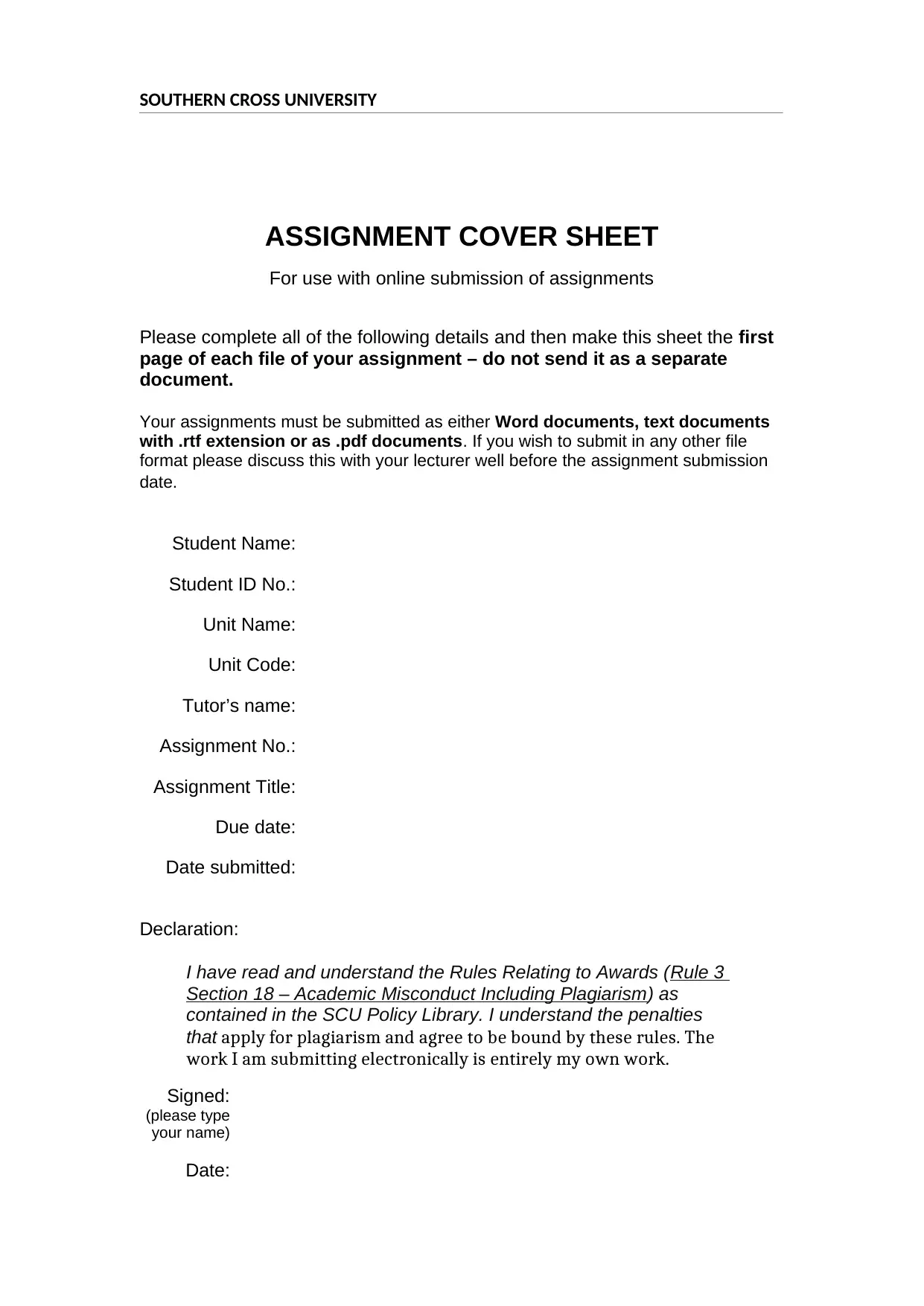
SOUTHERN CROSS UNIVERSITY
ASSIGNMENT COVER SHEET
For use with online submission of assignments
Please complete all of the following details and then make this sheet the first
page of each file of your assignment – do not send it as a separate
document.
Your assignments must be submitted as either Word documents, text documents
with .rtf extension or as .pdf documents. If you wish to submit in any other file
format please discuss this with your lecturer well before the assignment submission
date.
Student Name:
Student ID No.:
Unit Name:
Unit Code:
Tutor’s name:
Assignment No.:
Assignment Title:
Due date:
Date submitted:
Declaration:
I have read and understand the Rules Relating to Awards (Rule 3
Section 18 – Academic Misconduct Including Plagiarism) as
contained in the SCU Policy Library. I understand the penalties
that apply for plagiarism and agree to be bound by these rules. The
work I am submitting electronically is entirely my own work.
Signed:
(please type
your name)
Date:
ASSIGNMENT COVER SHEET
For use with online submission of assignments
Please complete all of the following details and then make this sheet the first
page of each file of your assignment – do not send it as a separate
document.
Your assignments must be submitted as either Word documents, text documents
with .rtf extension or as .pdf documents. If you wish to submit in any other file
format please discuss this with your lecturer well before the assignment submission
date.
Student Name:
Student ID No.:
Unit Name:
Unit Code:
Tutor’s name:
Assignment No.:
Assignment Title:
Due date:
Date submitted:
Declaration:
I have read and understand the Rules Relating to Awards (Rule 3
Section 18 – Academic Misconduct Including Plagiarism) as
contained in the SCU Policy Library. I understand the penalties
that apply for plagiarism and agree to be bound by these rules. The
work I am submitting electronically is entirely my own work.
Signed:
(please type
your name)
Date:
Paraphrase This Document
Need a fresh take? Get an instant paraphrase of this document with our AI Paraphraser
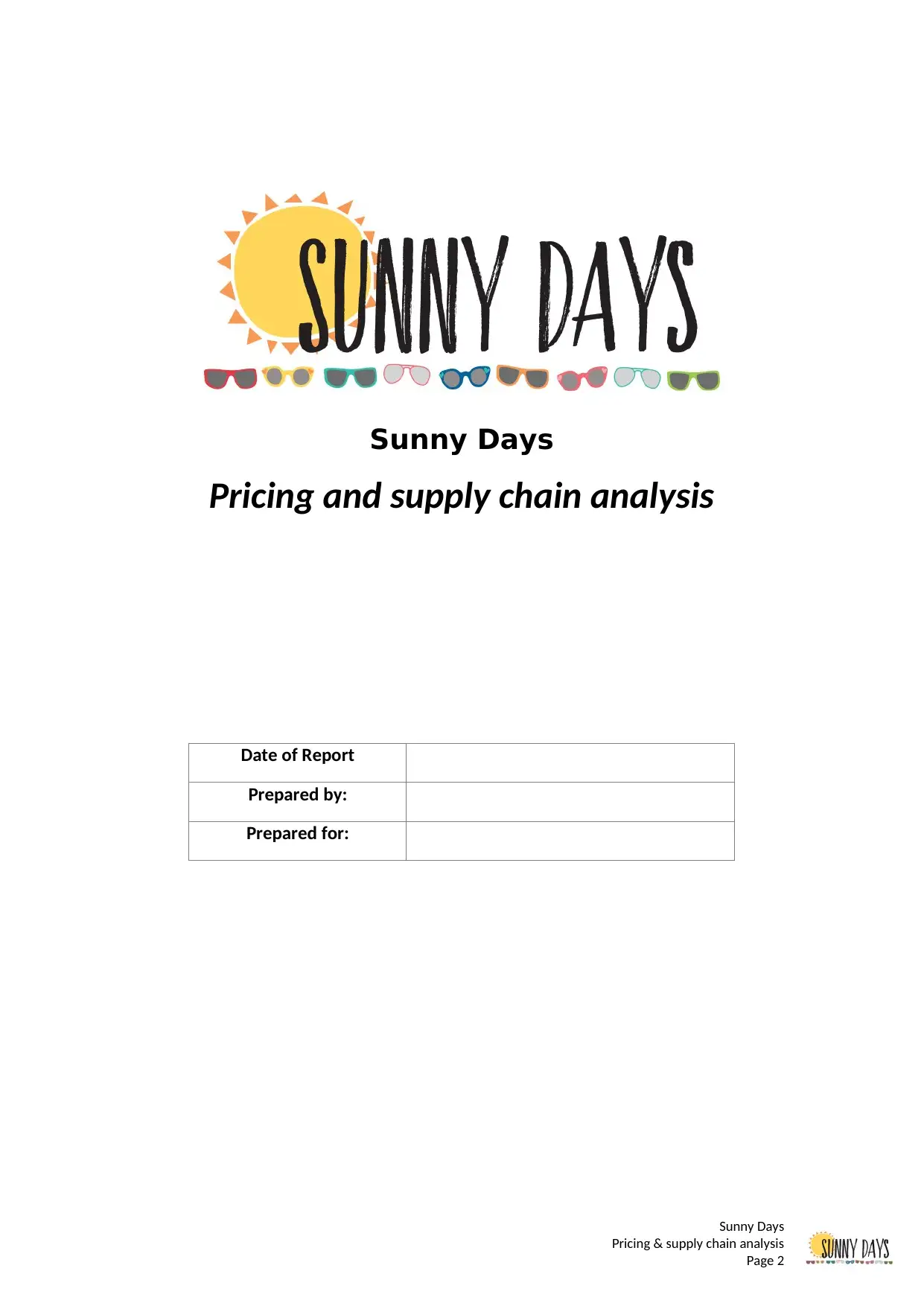
Sunny Days
Pricing and supply chain analysis
Date of Report
Prepared by:
Prepared for:
Sunny Days
Pricing & supply chain analysis
Page 2
Pricing and supply chain analysis
Date of Report
Prepared by:
Prepared for:
Sunny Days
Pricing & supply chain analysis
Page 2

1. Overview
Sunny days is engaged in manufacturing beach accessories and swimwear for
women as well as men. Different products they deal include One-piece swimsuits for
women, Board shorts for men, Beach Towels, Beach Umbrellas. Recently the board
of directors approved the budget for 2019 prepared by management accountant.
Target profit margin of company for each product is minimum 20% (Kaplan &
Atkinson, 2015). The report will analyse the pricing strategies and value chain
analysis to assist the entity in achieving the objectives and strategic goals for the
year 2019.
2. Target Pricing Analysis
If the target profit margin is 20% the target cost for the given sales
revenue will be as follows –
From the above it can be analysed that for achieving the target of 20%
profit margin with the given selling prices, target cost for one-piece shall be $ 80,
for board shorts shall be $ 64, for towels shall be $ 40 and for umbrella shall be $
36.
2. Supply Chain Analysis
Recommendation for maintaining or achieving target profit margin through
opportunities of supply chain
Resources for supply chain actually are not a cost rather it is an
investment for enhancing the profit margins. However, importance of supply
chain has been understood only by some big MNCs (Shin & Eksioglu, 2014).
Target profit margin can be achieved or maintained through improving the
supply chain through following –
Ranking the suppliers as well as customers based on gross margin – both
the customers as well as the vendors shall be ranked straightforward on
the basis of analyzing the top to bottom gross profit and determining
which group account for highest margin percentage. It has different
advantages as it delivers a structure for managing sales as well as
procurement function in future and it may lead for improving the process
that will hold the team accountable for the performance of suppliers and
customers (Ghosh & Shah, 2015).
Refine the analysis sales channel – starting analyzing the way in which the
customer orders come in. these orders shall be broken into discrete sales
channels. Instead of designating the customer type on the basis of single
location, independent or chain the sales channel attributes shall be
Sunny Days
Pricing & supply chain analysis
Page 3
Sunny days is engaged in manufacturing beach accessories and swimwear for
women as well as men. Different products they deal include One-piece swimsuits for
women, Board shorts for men, Beach Towels, Beach Umbrellas. Recently the board
of directors approved the budget for 2019 prepared by management accountant.
Target profit margin of company for each product is minimum 20% (Kaplan &
Atkinson, 2015). The report will analyse the pricing strategies and value chain
analysis to assist the entity in achieving the objectives and strategic goals for the
year 2019.
2. Target Pricing Analysis
If the target profit margin is 20% the target cost for the given sales
revenue will be as follows –
From the above it can be analysed that for achieving the target of 20%
profit margin with the given selling prices, target cost for one-piece shall be $ 80,
for board shorts shall be $ 64, for towels shall be $ 40 and for umbrella shall be $
36.
2. Supply Chain Analysis
Recommendation for maintaining or achieving target profit margin through
opportunities of supply chain
Resources for supply chain actually are not a cost rather it is an
investment for enhancing the profit margins. However, importance of supply
chain has been understood only by some big MNCs (Shin & Eksioglu, 2014).
Target profit margin can be achieved or maintained through improving the
supply chain through following –
Ranking the suppliers as well as customers based on gross margin – both
the customers as well as the vendors shall be ranked straightforward on
the basis of analyzing the top to bottom gross profit and determining
which group account for highest margin percentage. It has different
advantages as it delivers a structure for managing sales as well as
procurement function in future and it may lead for improving the process
that will hold the team accountable for the performance of suppliers and
customers (Ghosh & Shah, 2015).
Refine the analysis sales channel – starting analyzing the way in which the
customer orders come in. these orders shall be broken into discrete sales
channels. Instead of designating the customer type on the basis of single
location, independent or chain the sales channel attributes shall be
Sunny Days
Pricing & supply chain analysis
Page 3
⊘ This is a preview!⊘
Do you want full access?
Subscribe today to unlock all pages.

Trusted by 1+ million students worldwide
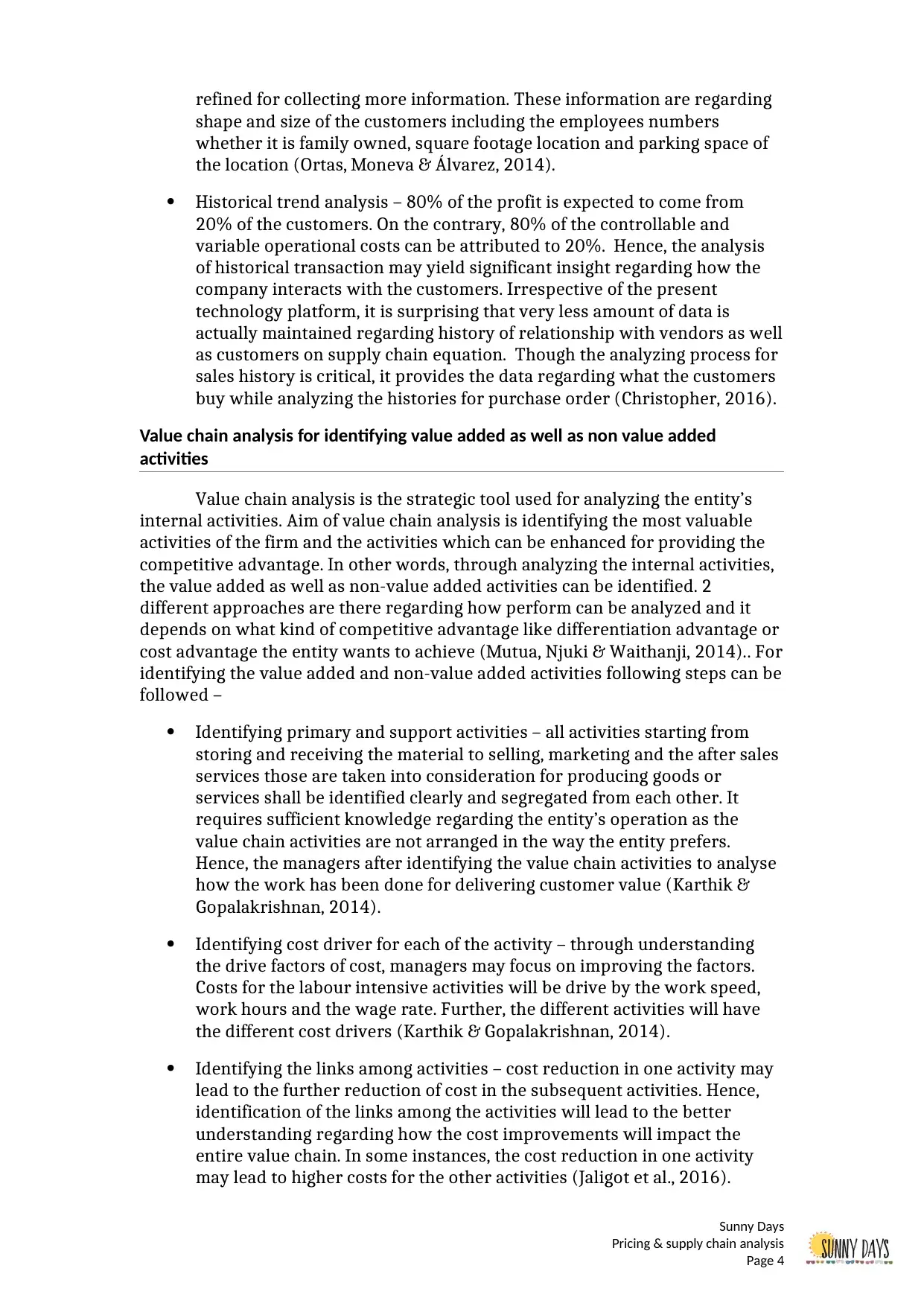
refined for collecting more information. These information are regarding
shape and size of the customers including the employees numbers
whether it is family owned, square footage location and parking space of
the location (Ortas, Moneva & Álvarez, 2014).
Historical trend analysis – 80% of the profit is expected to come from
20% of the customers. On the contrary, 80% of the controllable and
variable operational costs can be attributed to 20%. Hence, the analysis
of historical transaction may yield significant insight regarding how the
company interacts with the customers. Irrespective of the present
technology platform, it is surprising that very less amount of data is
actually maintained regarding history of relationship with vendors as well
as customers on supply chain equation. Though the analyzing process for
sales history is critical, it provides the data regarding what the customers
buy while analyzing the histories for purchase order (Christopher, 2016).
Value chain analysis for identifying value added as well as non value added
activities
Value chain analysis is the strategic tool used for analyzing the entity’s
internal activities. Aim of value chain analysis is identifying the most valuable
activities of the firm and the activities which can be enhanced for providing the
competitive advantage. In other words, through analyzing the internal activities,
the value added as well as non-value added activities can be identified. 2
different approaches are there regarding how perform can be analyzed and it
depends on what kind of competitive advantage like differentiation advantage or
cost advantage the entity wants to achieve (Mutua, Njuki & Waithanji, 2014).. For
identifying the value added and non-value added activities following steps can be
followed –
Identifying primary and support activities – all activities starting from
storing and receiving the material to selling, marketing and the after sales
services those are taken into consideration for producing goods or
services shall be identified clearly and segregated from each other. It
requires sufficient knowledge regarding the entity’s operation as the
value chain activities are not arranged in the way the entity prefers.
Hence, the managers after identifying the value chain activities to analyse
how the work has been done for delivering customer value (Karthik &
Gopalakrishnan, 2014).
Identifying cost driver for each of the activity – through understanding
the drive factors of cost, managers may focus on improving the factors.
Costs for the labour intensive activities will be drive by the work speed,
work hours and the wage rate. Further, the different activities will have
the different cost drivers (Karthik & Gopalakrishnan, 2014).
Identifying the links among activities – cost reduction in one activity may
lead to the further reduction of cost in the subsequent activities. Hence,
identification of the links among the activities will lead to the better
understanding regarding how the cost improvements will impact the
entire value chain. In some instances, the cost reduction in one activity
may lead to higher costs for the other activities (Jaligot et al., 2016).
Sunny Days
Pricing & supply chain analysis
Page 4
shape and size of the customers including the employees numbers
whether it is family owned, square footage location and parking space of
the location (Ortas, Moneva & Álvarez, 2014).
Historical trend analysis – 80% of the profit is expected to come from
20% of the customers. On the contrary, 80% of the controllable and
variable operational costs can be attributed to 20%. Hence, the analysis
of historical transaction may yield significant insight regarding how the
company interacts with the customers. Irrespective of the present
technology platform, it is surprising that very less amount of data is
actually maintained regarding history of relationship with vendors as well
as customers on supply chain equation. Though the analyzing process for
sales history is critical, it provides the data regarding what the customers
buy while analyzing the histories for purchase order (Christopher, 2016).
Value chain analysis for identifying value added as well as non value added
activities
Value chain analysis is the strategic tool used for analyzing the entity’s
internal activities. Aim of value chain analysis is identifying the most valuable
activities of the firm and the activities which can be enhanced for providing the
competitive advantage. In other words, through analyzing the internal activities,
the value added as well as non-value added activities can be identified. 2
different approaches are there regarding how perform can be analyzed and it
depends on what kind of competitive advantage like differentiation advantage or
cost advantage the entity wants to achieve (Mutua, Njuki & Waithanji, 2014).. For
identifying the value added and non-value added activities following steps can be
followed –
Identifying primary and support activities – all activities starting from
storing and receiving the material to selling, marketing and the after sales
services those are taken into consideration for producing goods or
services shall be identified clearly and segregated from each other. It
requires sufficient knowledge regarding the entity’s operation as the
value chain activities are not arranged in the way the entity prefers.
Hence, the managers after identifying the value chain activities to analyse
how the work has been done for delivering customer value (Karthik &
Gopalakrishnan, 2014).
Identifying cost driver for each of the activity – through understanding
the drive factors of cost, managers may focus on improving the factors.
Costs for the labour intensive activities will be drive by the work speed,
work hours and the wage rate. Further, the different activities will have
the different cost drivers (Karthik & Gopalakrishnan, 2014).
Identifying the links among activities – cost reduction in one activity may
lead to the further reduction of cost in the subsequent activities. Hence,
identification of the links among the activities will lead to the better
understanding regarding how the cost improvements will impact the
entire value chain. In some instances, the cost reduction in one activity
may lead to higher costs for the other activities (Jaligot et al., 2016).
Sunny Days
Pricing & supply chain analysis
Page 4
Paraphrase This Document
Need a fresh take? Get an instant paraphrase of this document with our AI Paraphraser
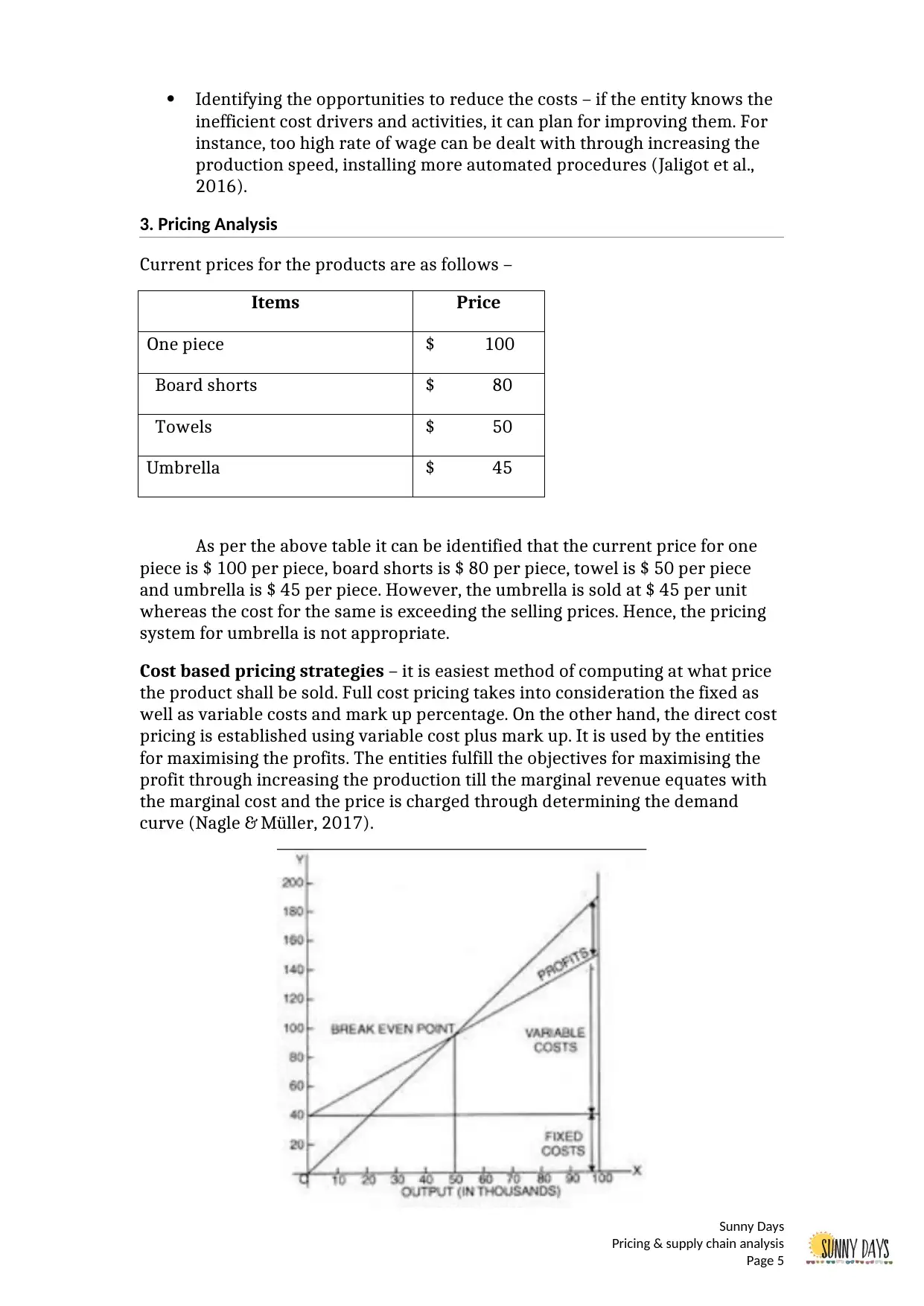
Identifying the opportunities to reduce the costs – if the entity knows the
inefficient cost drivers and activities, it can plan for improving them. For
instance, too high rate of wage can be dealt with through increasing the
production speed, installing more automated procedures (Jaligot et al.,
2016).
3. Pricing Analysis
Current prices for the products are as follows –
Items Price
One piece $ 100
Board shorts $ 80
Towels $ 50
Umbrella $ 45
As per the above table it can be identified that the current price for one
piece is $ 100 per piece, board shorts is $ 80 per piece, towel is $ 50 per piece
and umbrella is $ 45 per piece. However, the umbrella is sold at $ 45 per unit
whereas the cost for the same is exceeding the selling prices. Hence, the pricing
system for umbrella is not appropriate.
Cost based pricing strategies – it is easiest method of computing at what price
the product shall be sold. Full cost pricing takes into consideration the fixed as
well as variable costs and mark up percentage. On the other hand, the direct cost
pricing is established using variable cost plus mark up. It is used by the entities
for maximising the profits. The entities fulfill the objectives for maximising the
profit through increasing the production till the marginal revenue equates with
the marginal cost and the price is charged through determining the demand
curve (Nagle & Müller, 2017).
Sunny Days
Pricing & supply chain analysis
Page 5
inefficient cost drivers and activities, it can plan for improving them. For
instance, too high rate of wage can be dealt with through increasing the
production speed, installing more automated procedures (Jaligot et al.,
2016).
3. Pricing Analysis
Current prices for the products are as follows –
Items Price
One piece $ 100
Board shorts $ 80
Towels $ 50
Umbrella $ 45
As per the above table it can be identified that the current price for one
piece is $ 100 per piece, board shorts is $ 80 per piece, towel is $ 50 per piece
and umbrella is $ 45 per piece. However, the umbrella is sold at $ 45 per unit
whereas the cost for the same is exceeding the selling prices. Hence, the pricing
system for umbrella is not appropriate.
Cost based pricing strategies – it is easiest method of computing at what price
the product shall be sold. Full cost pricing takes into consideration the fixed as
well as variable costs and mark up percentage. On the other hand, the direct cost
pricing is established using variable cost plus mark up. It is used by the entities
for maximising the profits. The entities fulfill the objectives for maximising the
profit through increasing the production till the marginal revenue equates with
the marginal cost and the price is charged through determining the demand
curve (Nagle & Müller, 2017).
Sunny Days
Pricing & supply chain analysis
Page 5
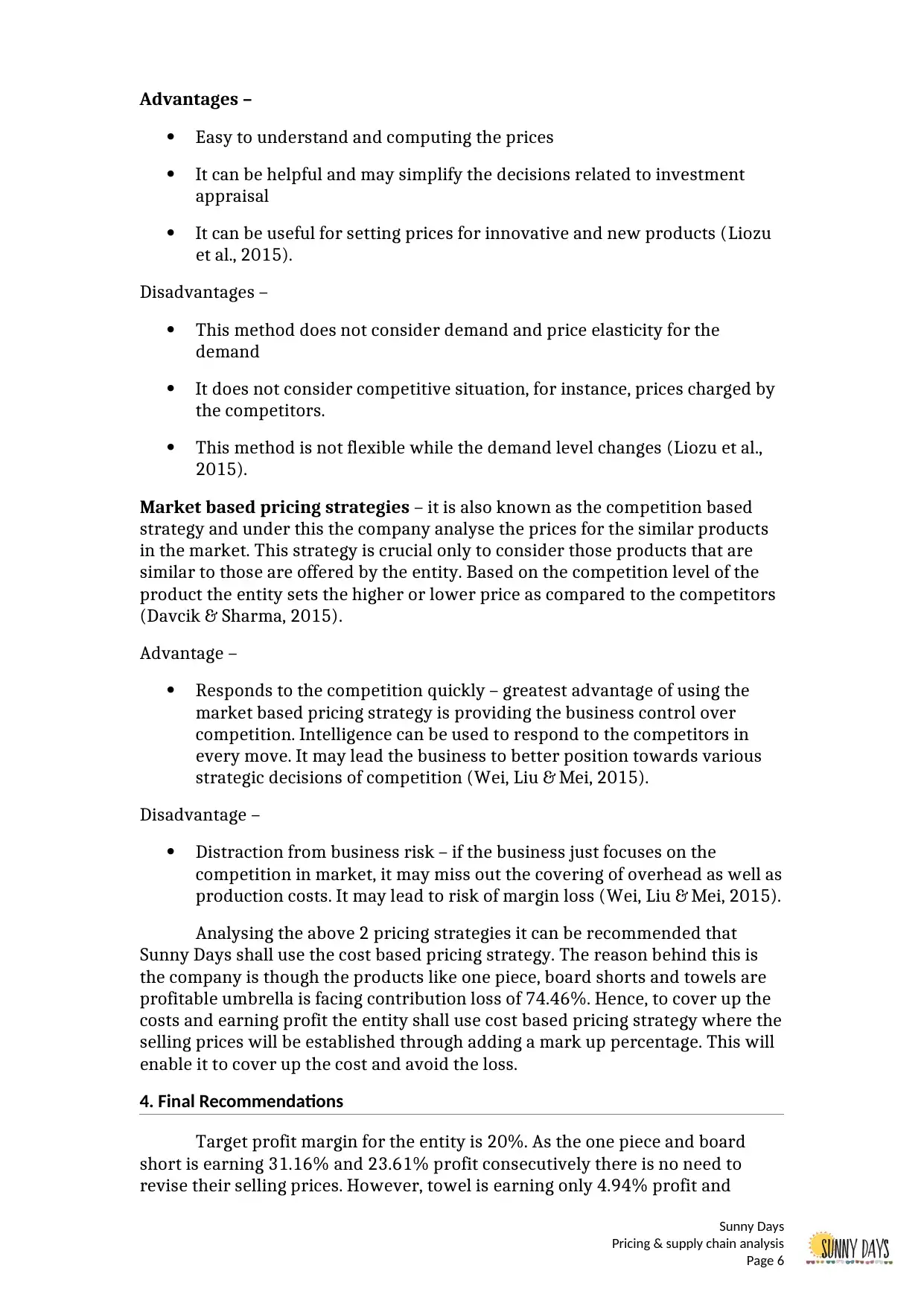
Advantages –
Easy to understand and computing the prices
It can be helpful and may simplify the decisions related to investment
appraisal
It can be useful for setting prices for innovative and new products (Liozu
et al., 2015).
Disadvantages –
This method does not consider demand and price elasticity for the
demand
It does not consider competitive situation, for instance, prices charged by
the competitors.
This method is not flexible while the demand level changes (Liozu et al.,
2015).
Market based pricing strategies – it is also known as the competition based
strategy and under this the company analyse the prices for the similar products
in the market. This strategy is crucial only to consider those products that are
similar to those are offered by the entity. Based on the competition level of the
product the entity sets the higher or lower price as compared to the competitors
(Davcik & Sharma, 2015).
Advantage –
Responds to the competition quickly – greatest advantage of using the
market based pricing strategy is providing the business control over
competition. Intelligence can be used to respond to the competitors in
every move. It may lead the business to better position towards various
strategic decisions of competition (Wei, Liu & Mei, 2015).
Disadvantage –
Distraction from business risk – if the business just focuses on the
competition in market, it may miss out the covering of overhead as well as
production costs. It may lead to risk of margin loss (Wei, Liu & Mei, 2015).
Analysing the above 2 pricing strategies it can be recommended that
Sunny Days shall use the cost based pricing strategy. The reason behind this is
the company is though the products like one piece, board shorts and towels are
profitable umbrella is facing contribution loss of 74.46%. Hence, to cover up the
costs and earning profit the entity shall use cost based pricing strategy where the
selling prices will be established through adding a mark up percentage. This will
enable it to cover up the cost and avoid the loss.
4. Final Recommendations
Target profit margin for the entity is 20%. As the one piece and board
short is earning 31.16% and 23.61% profit consecutively there is no need to
revise their selling prices. However, towel is earning only 4.94% profit and
Sunny Days
Pricing & supply chain analysis
Page 6
Easy to understand and computing the prices
It can be helpful and may simplify the decisions related to investment
appraisal
It can be useful for setting prices for innovative and new products (Liozu
et al., 2015).
Disadvantages –
This method does not consider demand and price elasticity for the
demand
It does not consider competitive situation, for instance, prices charged by
the competitors.
This method is not flexible while the demand level changes (Liozu et al.,
2015).
Market based pricing strategies – it is also known as the competition based
strategy and under this the company analyse the prices for the similar products
in the market. This strategy is crucial only to consider those products that are
similar to those are offered by the entity. Based on the competition level of the
product the entity sets the higher or lower price as compared to the competitors
(Davcik & Sharma, 2015).
Advantage –
Responds to the competition quickly – greatest advantage of using the
market based pricing strategy is providing the business control over
competition. Intelligence can be used to respond to the competitors in
every move. It may lead the business to better position towards various
strategic decisions of competition (Wei, Liu & Mei, 2015).
Disadvantage –
Distraction from business risk – if the business just focuses on the
competition in market, it may miss out the covering of overhead as well as
production costs. It may lead to risk of margin loss (Wei, Liu & Mei, 2015).
Analysing the above 2 pricing strategies it can be recommended that
Sunny Days shall use the cost based pricing strategy. The reason behind this is
the company is though the products like one piece, board shorts and towels are
profitable umbrella is facing contribution loss of 74.46%. Hence, to cover up the
costs and earning profit the entity shall use cost based pricing strategy where the
selling prices will be established through adding a mark up percentage. This will
enable it to cover up the cost and avoid the loss.
4. Final Recommendations
Target profit margin for the entity is 20%. As the one piece and board
short is earning 31.16% and 23.61% profit consecutively there is no need to
revise their selling prices. However, towel is earning only 4.94% profit and
Sunny Days
Pricing & supply chain analysis
Page 6
⊘ This is a preview!⊘
Do you want full access?
Subscribe today to unlock all pages.

Trusted by 1+ million students worldwide
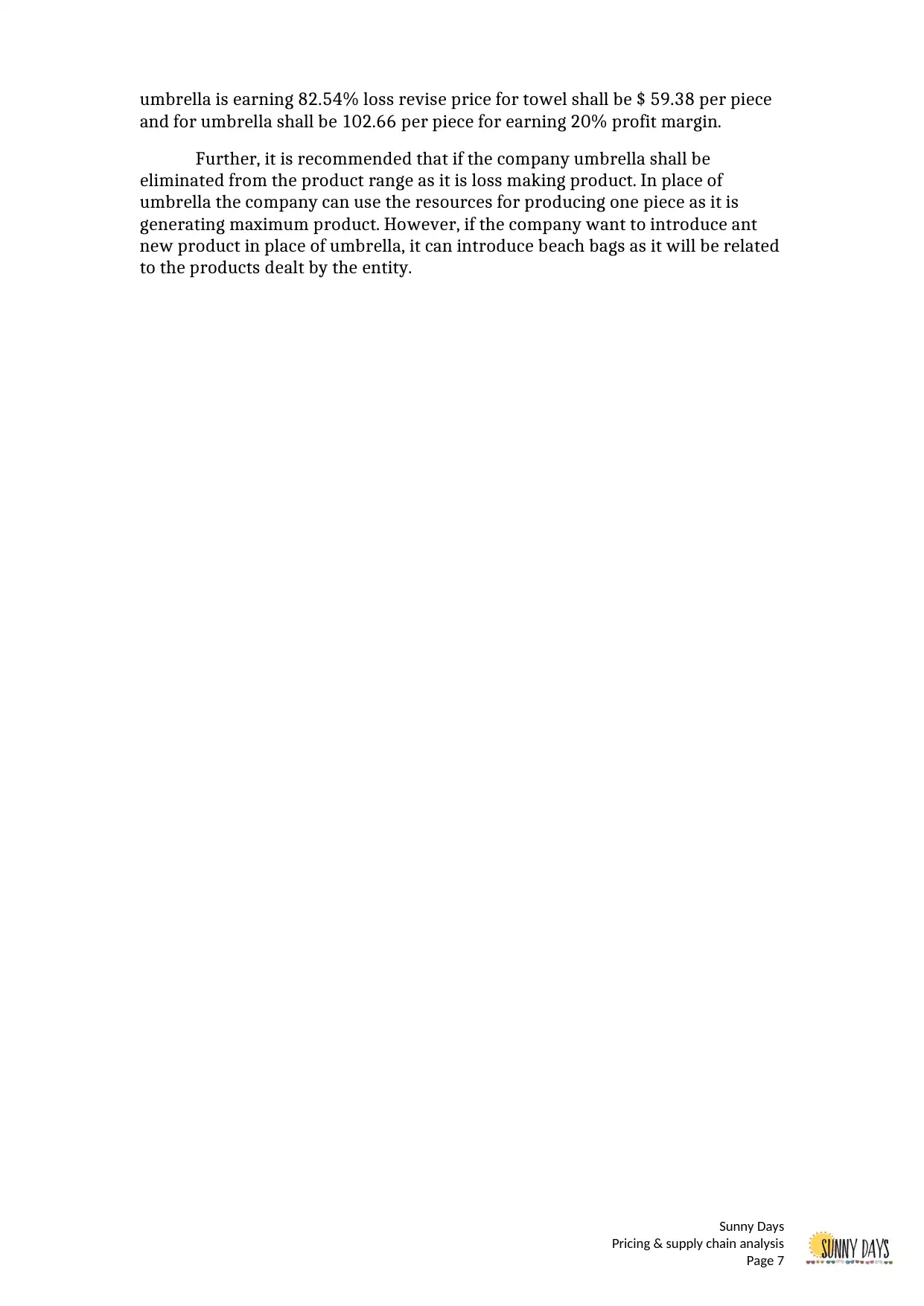
umbrella is earning 82.54% loss revise price for towel shall be $ 59.38 per piece
and for umbrella shall be 102.66 per piece for earning 20% profit margin.
Further, it is recommended that if the company umbrella shall be
eliminated from the product range as it is loss making product. In place of
umbrella the company can use the resources for producing one piece as it is
generating maximum product. However, if the company want to introduce ant
new product in place of umbrella, it can introduce beach bags as it will be related
to the products dealt by the entity.
Sunny Days
Pricing & supply chain analysis
Page 7
and for umbrella shall be 102.66 per piece for earning 20% profit margin.
Further, it is recommended that if the company umbrella shall be
eliminated from the product range as it is loss making product. In place of
umbrella the company can use the resources for producing one piece as it is
generating maximum product. However, if the company want to introduce ant
new product in place of umbrella, it can introduce beach bags as it will be related
to the products dealt by the entity.
Sunny Days
Pricing & supply chain analysis
Page 7
Paraphrase This Document
Need a fresh take? Get an instant paraphrase of this document with our AI Paraphraser
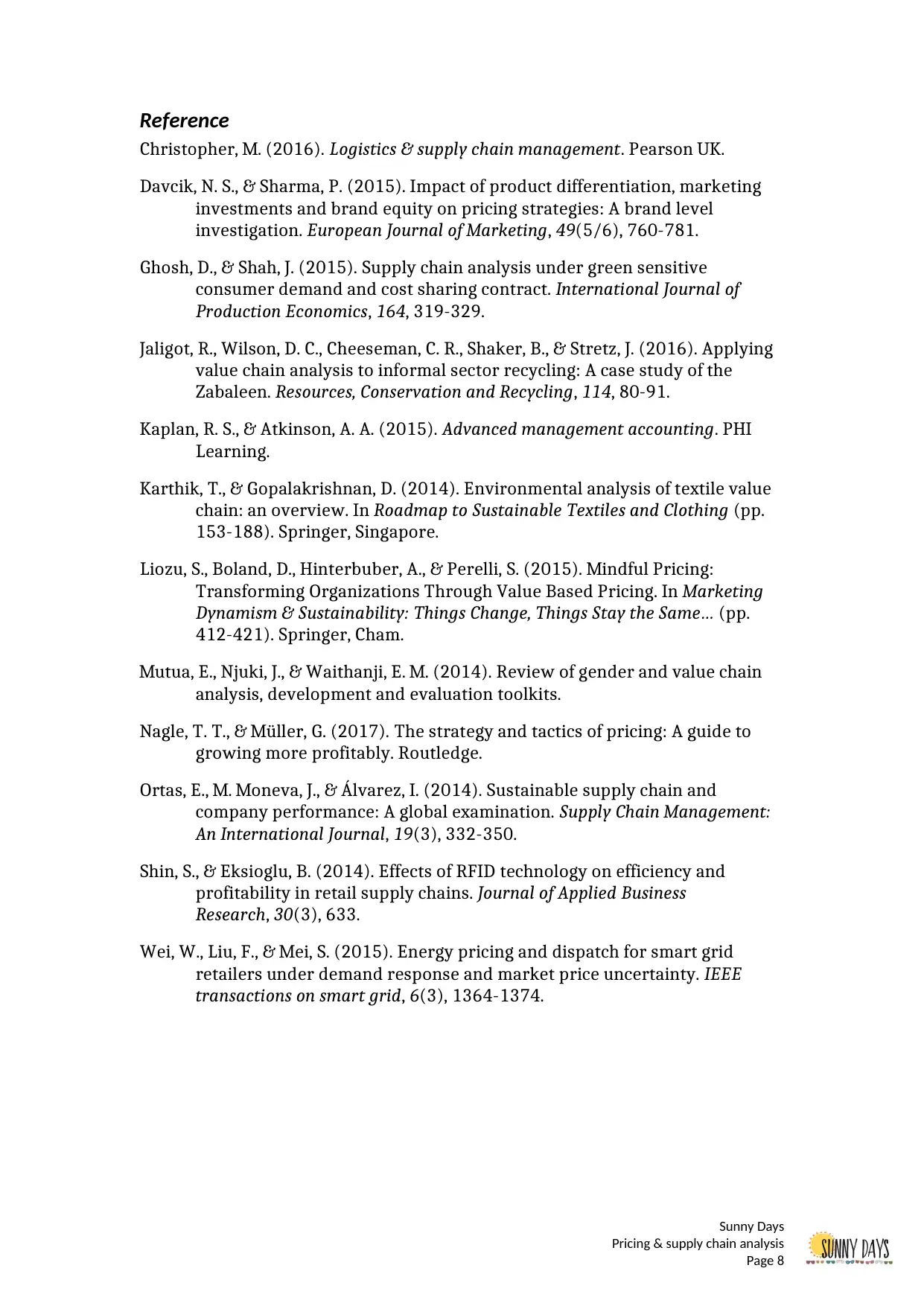
Reference
Christopher, M. (2016). Logistics & supply chain management. Pearson UK.
Davcik, N. S., & Sharma, P. (2015). Impact of product differentiation, marketing
investments and brand equity on pricing strategies: A brand level
investigation. European Journal of Marketing, 49(5/6), 760-781.
Ghosh, D., & Shah, J. (2015). Supply chain analysis under green sensitive
consumer demand and cost sharing contract. International Journal of
Production Economics, 164, 319-329.
Jaligot, R., Wilson, D. C., Cheeseman, C. R., Shaker, B., & Stretz, J. (2016). Applying
value chain analysis to informal sector recycling: A case study of the
Zabaleen. Resources, Conservation and Recycling, 114, 80-91.
Kaplan, R. S., & Atkinson, A. A. (2015). Advanced management accounting. PHI
Learning.
Karthik, T., & Gopalakrishnan, D. (2014). Environmental analysis of textile value
chain: an overview. In Roadmap to Sustainable Textiles and Clothing (pp.
153-188). Springer, Singapore.
Liozu, S., Boland, D., Hinterbuber, A., & Perelli, S. (2015). Mindful Pricing:
Transforming Organizations Through Value Based Pricing. In Marketing
Dynamism & Sustainability: Things Change, Things Stay the Same… (pp.
412-421). Springer, Cham.
Mutua, E., Njuki, J., & Waithanji, E. M. (2014). Review of gender and value chain
analysis, development and evaluation toolkits.
Nagle, T. T., & Müller, G. (2017). The strategy and tactics of pricing: A guide to
growing more profitably. Routledge.
Ortas, E., M. Moneva, J., & Álvarez, I. (2014). Sustainable supply chain and
company performance: A global examination. Supply Chain Management:
An International Journal, 19(3), 332-350.
Shin, S., & Eksioglu, B. (2014). Effects of RFID technology on efficiency and
profitability in retail supply chains. Journal of Applied Business
Research, 30(3), 633.
Wei, W., Liu, F., & Mei, S. (2015). Energy pricing and dispatch for smart grid
retailers under demand response and market price uncertainty. IEEE
transactions on smart grid, 6(3), 1364-1374.
Sunny Days
Pricing & supply chain analysis
Page 8
Christopher, M. (2016). Logistics & supply chain management. Pearson UK.
Davcik, N. S., & Sharma, P. (2015). Impact of product differentiation, marketing
investments and brand equity on pricing strategies: A brand level
investigation. European Journal of Marketing, 49(5/6), 760-781.
Ghosh, D., & Shah, J. (2015). Supply chain analysis under green sensitive
consumer demand and cost sharing contract. International Journal of
Production Economics, 164, 319-329.
Jaligot, R., Wilson, D. C., Cheeseman, C. R., Shaker, B., & Stretz, J. (2016). Applying
value chain analysis to informal sector recycling: A case study of the
Zabaleen. Resources, Conservation and Recycling, 114, 80-91.
Kaplan, R. S., & Atkinson, A. A. (2015). Advanced management accounting. PHI
Learning.
Karthik, T., & Gopalakrishnan, D. (2014). Environmental analysis of textile value
chain: an overview. In Roadmap to Sustainable Textiles and Clothing (pp.
153-188). Springer, Singapore.
Liozu, S., Boland, D., Hinterbuber, A., & Perelli, S. (2015). Mindful Pricing:
Transforming Organizations Through Value Based Pricing. In Marketing
Dynamism & Sustainability: Things Change, Things Stay the Same… (pp.
412-421). Springer, Cham.
Mutua, E., Njuki, J., & Waithanji, E. M. (2014). Review of gender and value chain
analysis, development and evaluation toolkits.
Nagle, T. T., & Müller, G. (2017). The strategy and tactics of pricing: A guide to
growing more profitably. Routledge.
Ortas, E., M. Moneva, J., & Álvarez, I. (2014). Sustainable supply chain and
company performance: A global examination. Supply Chain Management:
An International Journal, 19(3), 332-350.
Shin, S., & Eksioglu, B. (2014). Effects of RFID technology on efficiency and
profitability in retail supply chains. Journal of Applied Business
Research, 30(3), 633.
Wei, W., Liu, F., & Mei, S. (2015). Energy pricing and dispatch for smart grid
retailers under demand response and market price uncertainty. IEEE
transactions on smart grid, 6(3), 1364-1374.
Sunny Days
Pricing & supply chain analysis
Page 8
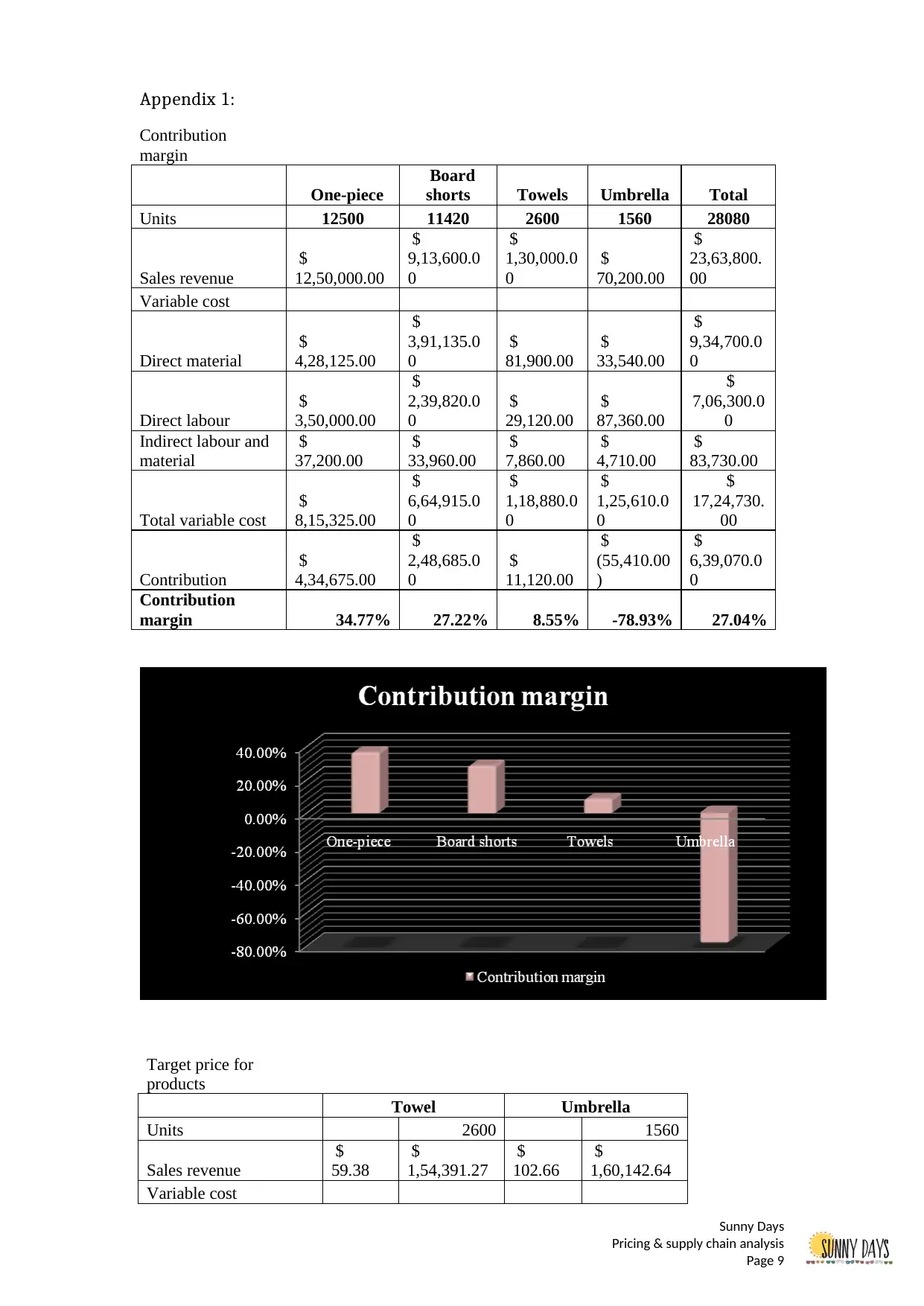
Appendix 1:
Contribution
margin
One-piece
Board
shorts Towels Umbrella Total
Units 12500 11420 2600 1560 28080
Sales revenue
$
12,50,000.00
$
9,13,600.0
0
$
1,30,000.0
0
$
70,200.00
$
23,63,800.
00
Variable cost
Direct material
$
4,28,125.00
$
3,91,135.0
0
$
81,900.00
$
33,540.00
$
9,34,700.0
0
Direct labour
$
3,50,000.00
$
2,39,820.0
0
$
29,120.00
$
87,360.00
$
7,06,300.0
0
Indirect labour and
material
$
37,200.00
$
33,960.00
$
7,860.00
$
4,710.00
$
83,730.00
Total variable cost
$
8,15,325.00
$
6,64,915.0
0
$
1,18,880.0
0
$
1,25,610.0
0
$
17,24,730.
00
Contribution
$
4,34,675.00
$
2,48,685.0
0
$
11,120.00
$
(55,410.00
)
$
6,39,070.0
0
Contribution
margin 34.77% 27.22% 8.55% -78.93% 27.04%
Target price for
products
Towel Umbrella
Units 2600 1560
Sales revenue
$
59.38
$
1,54,391.27
$
102.66
$
1,60,142.64
Variable cost
Sunny Days
Pricing & supply chain analysis
Page 9
Contribution
margin
One-piece
Board
shorts Towels Umbrella Total
Units 12500 11420 2600 1560 28080
Sales revenue
$
12,50,000.00
$
9,13,600.0
0
$
1,30,000.0
0
$
70,200.00
$
23,63,800.
00
Variable cost
Direct material
$
4,28,125.00
$
3,91,135.0
0
$
81,900.00
$
33,540.00
$
9,34,700.0
0
Direct labour
$
3,50,000.00
$
2,39,820.0
0
$
29,120.00
$
87,360.00
$
7,06,300.0
0
Indirect labour and
material
$
37,200.00
$
33,960.00
$
7,860.00
$
4,710.00
$
83,730.00
Total variable cost
$
8,15,325.00
$
6,64,915.0
0
$
1,18,880.0
0
$
1,25,610.0
0
$
17,24,730.
00
Contribution
$
4,34,675.00
$
2,48,685.0
0
$
11,120.00
$
(55,410.00
)
$
6,39,070.0
0
Contribution
margin 34.77% 27.22% 8.55% -78.93% 27.04%
Target price for
products
Towel Umbrella
Units 2600 1560
Sales revenue
$
59.38
$
1,54,391.27
$
102.66
$
1,60,142.64
Variable cost
Sunny Days
Pricing & supply chain analysis
Page 9
⊘ This is a preview!⊘
Do you want full access?
Subscribe today to unlock all pages.

Trusted by 1+ million students worldwide

Direct material
$
31.50
$
81,900.00
$
21.50
$
33,540.00
Direct labour
$
11.20
$
29,120.00
$
56.00
$
87,360.00
Other Variable Cost
$
3.00
$
7,800.00
$
3.00
$
4,680.00
Total variable cost
$
45.70
$
1,18,820.00
$
80.50
$
1,25,580.00
Contribution
$
13.68
$
35,571.27
$
22.16
$
34,562.64
Contribution margin 23.0% 23.0% 21.6% 21.6%
Fixed Costs
$
4,693.00
$
2,534.00
Profit
$
30,878.27
$
32,028.64
Profit Margin 20.00% 20.00%
Sunny Days
Pricing & supply chain analysis
Page 10
$
31.50
$
81,900.00
$
21.50
$
33,540.00
Direct labour
$
11.20
$
29,120.00
$
56.00
$
87,360.00
Other Variable Cost
$
3.00
$
7,800.00
$
3.00
$
4,680.00
Total variable cost
$
45.70
$
1,18,820.00
$
80.50
$
1,25,580.00
Contribution
$
13.68
$
35,571.27
$
22.16
$
34,562.64
Contribution margin 23.0% 23.0% 21.6% 21.6%
Fixed Costs
$
4,693.00
$
2,534.00
Profit
$
30,878.27
$
32,028.64
Profit Margin 20.00% 20.00%
Sunny Days
Pricing & supply chain analysis
Page 10
1 out of 10
Related Documents
Your All-in-One AI-Powered Toolkit for Academic Success.
+13062052269
info@desklib.com
Available 24*7 on WhatsApp / Email
![[object Object]](/_next/static/media/star-bottom.7253800d.svg)
Unlock your academic potential
Copyright © 2020–2025 A2Z Services. All Rights Reserved. Developed and managed by ZUCOL.





